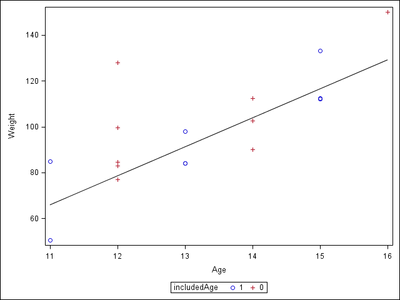- Home
- /
- Programming
- /
- SAS Procedures
- /
- Re: Skip data
- RSS Feed
- Mark Topic as New
- Mark Topic as Read
- Float this Topic for Current User
- Bookmark
- Subscribe
- Mute
- Printer Friendly Page
- Mark as New
- Bookmark
- Subscribe
- Mute
- RSS Feed
- Permalink
- Report Inappropriate Content
Hello
I am asking for help which I want to explain in the following example:
I have data of 100 firms for the period 2000-2008. the data includes profit and No of directors for every firm.
I want to estimate a model that takes the profit data of years 2001,2003,2005,2007 directors data of the years 2000,2002,2004,2006.
Which functions in SAS I have to read in order to proceed with it
Thanks a lot!!!!
Accepted Solutions
- Mark as New
- Bookmark
- Subscribe
- Mute
- RSS Feed
- Permalink
- Report Inappropriate Content
Here is an example where I model Weight as a function of Age, only for odd ages and use the model to estimate the weight of students of even ages.
data regClass;
set sashelp.class;
/* Decide which ages to include in the model */
includedAge = mod(age,2);
/* Copy only included weights, other will be set to missing */
if includedAge then regWeight = weight;
run;
/* Estimate the model, output predictions for all observations */
proc reg data=regClass plots=none;
model regWeight = age;
output out=predClass p=predWeight;
run;
proc sort data=predClass; by age; run;
proc sgplot data=predClass;
scatter x=age y=weight / group=includedAge;
series x=age y=predWeight;
run;
of course, proc reg is only one of many procedures available to build predictive models, but most procs work about the same way.
- Mark as New
- Bookmark
- Subscribe
- Mute
- RSS Feed
- Permalink
- Report Inappropriate Content
Without knowing what the data looks like its hard to say, is there a variable for year, if so then just where clause that:
where year in (2001,2003,2005,2007);
For example. To get good answers, it a good idea to post test data, in the form of a datastep, and what the output should be. Posting the relevant code in this instance would also illustrate it.
- Mark as New
- Bookmark
- Subscribe
- Mute
- RSS Feed
- Permalink
- Report Inappropriate Content
Here is an example where I model Weight as a function of Age, only for odd ages and use the model to estimate the weight of students of even ages.
data regClass;
set sashelp.class;
/* Decide which ages to include in the model */
includedAge = mod(age,2);
/* Copy only included weights, other will be set to missing */
if includedAge then regWeight = weight;
run;
/* Estimate the model, output predictions for all observations */
proc reg data=regClass plots=none;
model regWeight = age;
output out=predClass p=predWeight;
run;
proc sort data=predClass; by age; run;
proc sgplot data=predClass;
scatter x=age y=weight / group=includedAge;
series x=age y=predWeight;
run;
of course, proc reg is only one of many procedures available to build predictive models, but most procs work about the same way.
April 27 – 30 | Gaylord Texan | Grapevine, Texas
Registration is open
Walk in ready to learn. Walk out ready to deliver. This is the data and AI conference you can't afford to miss.
Register now and save with the early bird rate—just $795!
Learn the difference between classical and Bayesian statistical approaches and see a few PROC examples to perform Bayesian analysis in this video.
Find more tutorials on the SAS Users YouTube channel.
SAS Training: Just a Click Away
Ready to level-up your skills? Choose your own adventure.



